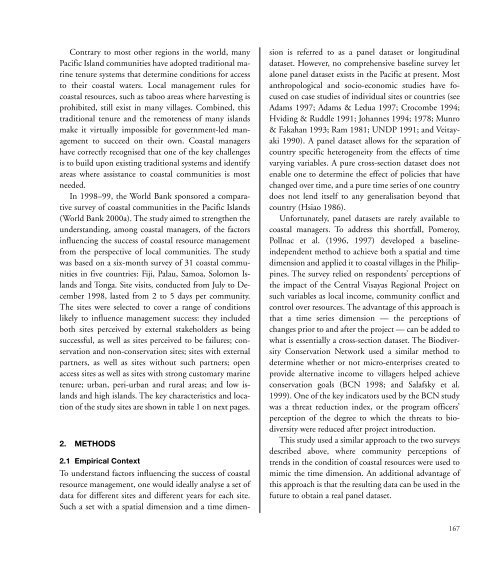You also want an ePaper? Increase the reach of your titles
YUMPU automatically turns print PDFs into web optimized ePapers that Google loves.
Contrary to most other regions in the world, many<br />
Pacific Island communities have adopted traditional marine<br />
tenure systems that determine conditions for access<br />
to their coastal waters. Local management rules for<br />
coastal resources, such as taboo areas where harvesting is<br />
prohibited, still exist in many villages. Combined, this<br />
traditional tenure and the remoteness <strong>of</strong> many islands<br />
make it virtually impossible for government-led management<br />
to succeed on their own. Coastal managers<br />
have correctly recognised that one <strong>of</strong> the key challenges<br />
is to build upon existing traditional systems and identify<br />
areas where assistance to coastal communities is most<br />
needed.<br />
In 1998–99, the World Bank sponsored a comparative<br />
survey <strong>of</strong> coastal communities in the Pacific Islands<br />
(World Bank 2000a). The study aimed to strengthen the<br />
understanding, among coastal managers, <strong>of</strong> the factors<br />
influencing the success <strong>of</strong> coastal resource management<br />
from the perspective <strong>of</strong> local communities. The study<br />
was based on a six-month survey <strong>of</strong> 31 coastal communities<br />
in five countries: Fiji, Palau, Samoa, Solomon Islands<br />
and Tonga. Site visits, conducted from July to December<br />
1998, lasted from 2 to 5 days per community.<br />
The sites were selected to cover a range <strong>of</strong> conditions<br />
likely to influence management success: they included<br />
both sites perceived by external stakeholders as being<br />
successful, as well as sites perceived to be failures; conservation<br />
and non-conservation sites; sites with external<br />
partners, as well as sites without such partners; open<br />
access sites as well as sites with strong customary marine<br />
tenure; urban, peri-urban and rural areas; and low islands<br />
and high islands. The key characteristics and location<br />
<strong>of</strong> the study sites are shown in table 1 on next pages.<br />
2. METHODS<br />
2.1 Empirical Context<br />
To understand factors influencing the success <strong>of</strong> coastal<br />
resource management, one would ideally analyse a set <strong>of</strong><br />
data for different sites and different years for each site.<br />
Such a set with a spatial dimension and a time dimension<br />
is referred to as a panel dataset or longitudinal<br />
dataset. However, no comprehensive baseline survey let<br />
alone panel dataset exists in the Pacific at present. Most<br />
anthropological and socio-economic studies have focused<br />
on case studies <strong>of</strong> individual sites or countries (see<br />
Adams 1997; Adams & Ledua 1997; Crocombe 1994;<br />
Hviding & Ruddle 1991; Johannes 1994; 1978; Munro<br />
& Fakahan 1993; Ram 1981; UNDP 1991; and Veitayaki<br />
1990). A panel dataset allows for the separation <strong>of</strong><br />
country specific heterogeneity from the effects <strong>of</strong> time<br />
varying variables. A pure cross-section dataset does not<br />
enable one to determine the effect <strong>of</strong> policies that have<br />
changed over time, and a pure time series <strong>of</strong> one country<br />
does not lend itself to any generalisation beyond that<br />
country (Hsiao 1986).<br />
Unfortunately, panel datasets are rarely available to<br />
coastal managers. To address this shortfall, Pomeroy,<br />
Pollnac et al. (1996, 1997) developed a baselineindependent<br />
method to achieve both a spatial and time<br />
dimension and applied it to coastal villages in the Philippines.<br />
The survey relied on respondents’ perceptions <strong>of</strong><br />
the impact <strong>of</strong> the Central Visayas Regional Project on<br />
such variables as local income, community conflict and<br />
control over resources. The advantage <strong>of</strong> this approach is<br />
that a time series dimension — the perceptions <strong>of</strong><br />
changes prior to and after the project — can be added to<br />
what is essentially a cross-section dataset. The Biodiversity<br />
Conservation Network used a similar method to<br />
determine whether or not micro-enterprises created to<br />
provide alternative income to villagers helped achieve<br />
conservation goals (BCN 1998; and Salafsky et al.<br />
1999). One <strong>of</strong> the key indicators used by the BCN study<br />
was a threat reduction index, or the program <strong>of</strong>ficers’<br />
perception <strong>of</strong> the degree to which the threats to biodiversity<br />
were reduced after project introduction.<br />
This study used a similar approach to the two surveys<br />
described above, where community perceptions <strong>of</strong><br />
trends in the condition <strong>of</strong> coastal resources were used to<br />
mimic the time dimension. An additional advantage <strong>of</strong><br />
this approach is that the resulting data can be used in the<br />
future to obtain a real panel dataset.<br />
167


















